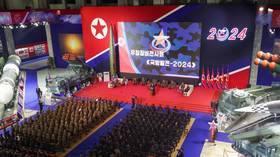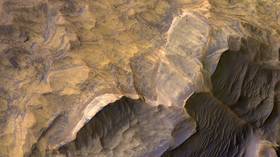‘New hope’ for true holograms after Tokyo researchers make major breakthrough
After decades of teasing and disappointment since ‘Star Wars: A New Hope’ took to the big screen in 1977, it appears the world may soon finally have proper holograms, following a breakthrough by Japanese researchers.
Using 'metasurface' materials which manipulate light at the nanoscale, a team of scientists at the Tokyo University of Agriculture and Technology (TUAT) have created a bonafide 3D hologram, visible from multiple viewing angles in respectable quality.
Static holograms, like hoverboards, have long been the somewhat disappointing real-world counterparts of much-hyped movie effects from big-screen hits like ‘Star Wars’ and ‘Back to the Future’.
These faux holograms are characterized by their underwhelming quality, still imagery, and extremely limited viewing angle – a phantom menace, if you will.
In recent years, 'holograms' of pop stars and cultural icons have appeared at concerts and art installations across the world, but they still wouldn't fit the bill as “true holograms,” and are instead merely a 21st century equivalent of an old parlor trick, essentially smoke and mirrors (with some lasers thrown in), which also have a limited viewing angle.
Also on rt.com 3D George Floyd hologram to 'replace' confederate monuments in southern US tour (VIDEOS)Enter the TUAT researchers who, inspired by the earliest cinematic projectors dating back to the 19th century, have created 3D light using metasurfaces, thin films of material just nanometers thick.
These metasurfaces manipulate light as it passes through tiny repeating patterns on their surface, on a scale smaller than the wavelength of light.
By painstakingly arranging and shaping these metasurface patterns in a highly specialized way, the researchers found they could alter the path of light as desired.
They then ‘printed’ 48 frames of metasurface, comprised mostly of gold, which diffracts laser light into three dimensions, producing a true holographic image in mid-air, viewable from most angles in a given room – though the film is, admittedly, still a little on the dark side.
They used an electron-beam printer to create 48 images of the Earth rotating, in a 6.5-hour process. The image was then reconstructed at a rate of 30 frames per second (the standard for live television).
At that pace, a six-minute movie would take 800 hours – roughly 33 days – to ‘print’. For reference, a production team took roughly one week to produce between one and two minutes of footage for the 2014 stop-motion fantasy film ‘The Boxtrolls’.
While the process is still in its infancy, it shows great promise for beleaguered sci-fi nerds everywhere, who hope to experience proper holograms after all these years.
The researchers aim to develop the system to one day produce full-color films using multiple kinds of laser. At present, the first holographic film has a reddish hue, owing to its helium-neon laser light source.
Think your friends would be interested? Share this story!
















